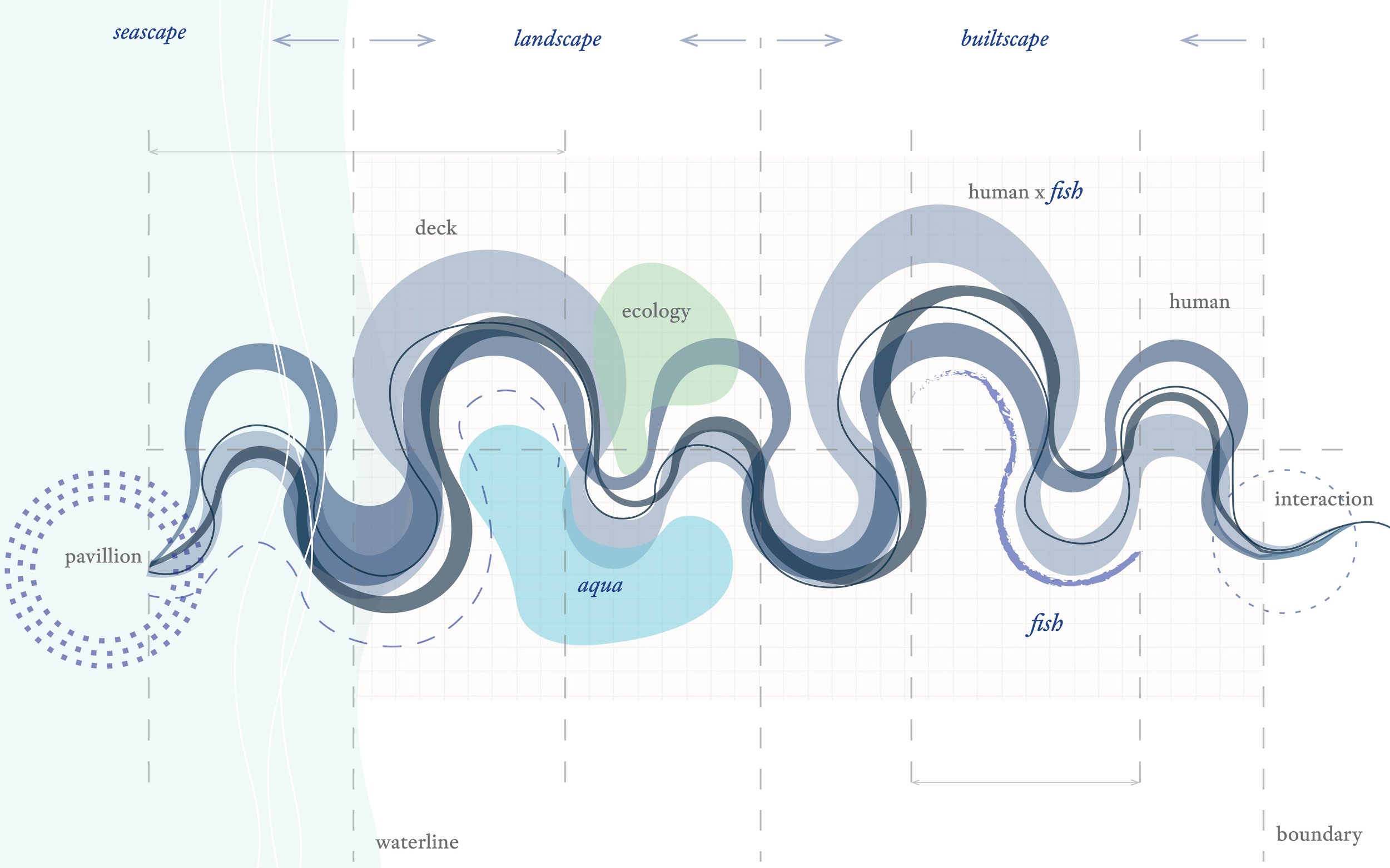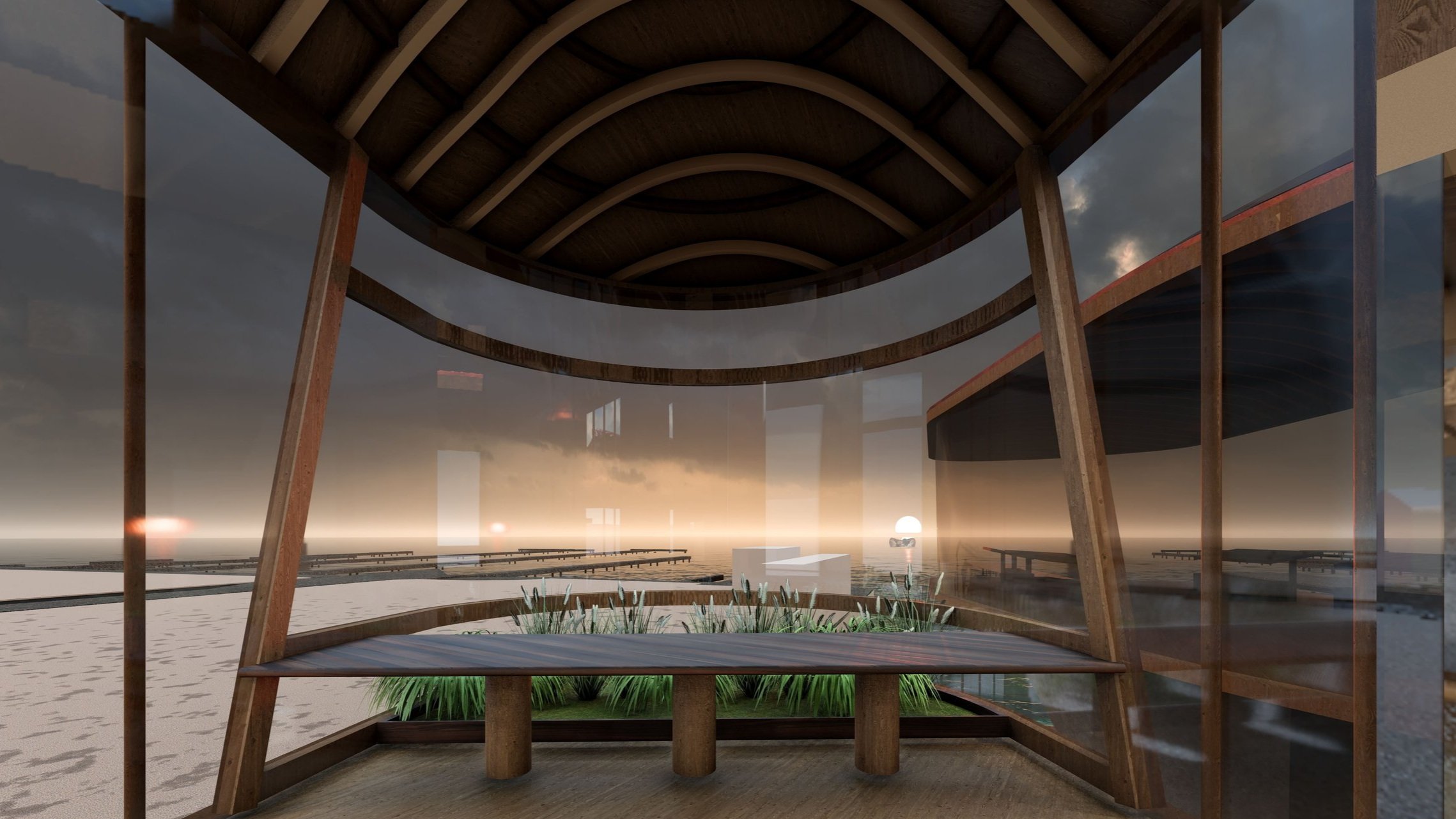
Aquagora
A vision for urban fishing & community - Thesis 2025
A haven to reconnect with aqua and celebrate the bonds that have linked humankind with aquatic ecology. This projects appreciates fishing as the means to learn about the life in water, connect with people and create a community that gathers to appreciate the art of fishing and educate one-another about the invisible strings that connect us to builtscape, landscape, and waterscape.
This thesis is a haven to reconnect with aqua and celebrate the bonds that have linked humankind with aquatic ecology. The project intends to see fishing as the means to learn about the life in water, connect with people and create a community that gathers to appreciate the art of fishing and educate one-another about the invisible strings that connect us to builtscape, landscape, and waterscape
Fishing has been a recorded occupation since the beginning of civilization, connecting people to the water, to nature, and to one another. Yet in a bustling city like New York , this connection has faded, reduced largely to recreational activities with little awareness of its ecological, cultural, and historical significance. This thesis addresses this loss by creating a space where fishing is not just practiced but celebrated and understood.
Fishing in American culture has been seen as a hobby by many than as an occupation. The activity itself brings a sense of calm, to be shared with friends and loved ones. By enabling fishing as an anchor, we can create a space that brings people together to resort from fast-walking and coffee-to-go New York City toward a realm to slow down and rewind time.
In my search of the right location to host this program, I was looking for a locality with existing community that already appreciates the intent and found City Island, Bronx (image 1). They are a small community at the edge of New York City located just beyond Pelham Bay Park and surrounded by the waters of western Long Island Sound and Eastchester Bay. It’s also one of NYC’s quieter tourist spots — known for its charter boats, nautical museum, and local businesses like bait and tackle shops, souvenir stores, art galleries, and scuba gear vendors. Residents even mentioned how recent efforts like the oyster reef project have brought back aquatic species they hadn’t seen in decades. That discovery made City Island feel like the right place — not just to design for the community, but to create something with them in mind. A space that gives them a platform to represent themselves, to educate the many visitors who pass through, and to support and extend their local businesses. Located along the spine of City Island, City Island Avenue on the West, is an abandoned boat yard with an existing floating dock. This site is also less than 0.5 miles from the City Island Bridge with a site area of around thirty thousand square feet.
The programming was derived based the flow of experiences and evolution of knowledge in the art of fishing. Starting from the site boundary on the right we can see the experience slowly introducing different interactions. Starting from humans when you enter and slowly building up your mind to open up to how fishing has shaped the world around us, inviting everyone into the aqua pavilion.
The program for the project reflects this layered purpose, that includes an exhibit space or museum that tells the story of fishing and aquatic life in New York, a fish library with preserved specimens and framed prints, and a Gyotaku workshop, where visitors can create their own traditional Japanese fish prints. There's also a fresh fish market, a culinary school that teaches people how to clean, fillet, cook, and eat fish. , and finally, a sea pavilion that provides access to charter boats, creating a full 360° experience of fishing, culture, and education. Each of these experiences is connected, so the learning is not static but continuous, from knowledge to interaction to immersion.
While developing the form of the project rather than separating the functions into isolated zones, the architecture allows one to move fluidly from exhibit to workshop to market, mimicking the flow of water, of time, and of learning. The site’s edge condition played a big role in shaping the design. The water here transitions from shallow to deeper zones a few feet offshore. I used this natural slope as a way to manipulate the edge, creating a contoured descent toward the water that strengthens the sensory and physical connection to it. It’s not a hard boundary but a soft gradient that invites people to approach the sea slowly and intentionally. The blocks are elevated to 15' from the ground level considering that the site is located in flood safety zone. This is a preparative solution to impending climate change and crisis, allowing people to seek refuge in the enclosed areas above. This also ensures that the design has open planning in the ground level with necessary landscaping elements (trees, plants, ponds, etc) with enough harscapes (pavement, seating, etc) to act as as viable spots for community engagement activities.
The design also includes arched piers that hold the programs between itself and the wave-like roof structure. These piers are unevenly sized across the site, sometimes making them occupiable to have
The seascape is has two elements majorly, one, the dock that leads you to small motorboats that act as water taxis, and two, the sea pavilion located 600' from the site from where one can board a charter boat to explore the fishing waters.
The entire massing also reflects the flow as well. The main building pulls back and opens toward the waterfront, offering framed views at key moments. The material palette is natural and nautical consisting of wood, concrete, glass, and copper tiles that stands as a testament to time and its effects. The sea pavilion, which leads visitors to the boats, is designed as a light, open canopy structure, like a net unfurling over the dock, evoking fishing equipment while remaining contemporary and accessible.
Overall, the project is about reclaiming time, celebrating place, and creating shared experiences. It’s a space for City Island residents to proudly showcase their knowledge and for New Yorkers and visitors to learn, slow down, and engage with the water in a new way. It’s about honoring what exists while creating opportunities for the future, through architecture that listens, connects, and gives space for stories to unfold.

















